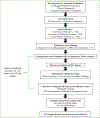Development of the Thought Disorder Measure for the Hierarchical Taxonomy of Psychopathology
- PMID: 34044614
- PMCID: PMC9900605
- DOI: 10.1177/10731911211015355
Development of the Thought Disorder Measure for the Hierarchical Taxonomy of Psychopathology
Abstract
The Hierarchical Taxonomy of Psychopathology consortium aims to develop a comprehensive self-report measure to assess psychopathology dimensionally. The current research describes the initial conceptualization, development, and item selection for the thought disorder spectrum and related constructs from other spectra. The thought disorder spectrum is defined primarily by the positive and disorganized traits and symptoms of schizophrenia-spectrum disorders. The Thought Disorder Sub-Workgroup identified and defined 16 relevant constructs and wrote 10 to 15 items per each construct. These items were administered, along with detachment and mania items, to undergraduates and people with serious mental illness. Three hundred and sixty-five items across 25 scales were administered. An exploratory factor analysis of the scale scores suggested a two-factor structure corresponding to positive and negative symptoms for two samples. The mania scales loaded with the positive factor, while the detachment scales loaded with the negative factor. Item-level analyses resulted in 19 preliminary scales, including 215 items that cover the range of thought disorder pathology, and will be carried forward for the next phase of data collection/analysis.
Keywords: confirmatory factor analysis; exploratory factor analysis; psychosis; schizophrenia; schizotypal personality; schizotypy.
Conflict of interest statement
Declaration of Conflicting Interests
The author(s) declared no potential conflicts of interest with respect to the research, authorship, and/or publication of this article.
Figures
References
-
- Andreasen NC (1982). Scale for the assessment of positive symptoms. University of Iowa, Department of Psychiatry.
-
- Andreasen NC (1984). Scale for the assessment of negative symptoms. University of Iowa College of Medicine.
-
- Ashton MC, Lee K, de Vries RE, Hendrickse J, & Born MP (2012). The maladaptive personality traits of the Personality Inventory for DSM-5 (PID-5) in relation to the HEXACO personality factors and schizotypy/dissociation. Journal of Personality Disorders, 26(5), 641–659. 10.1521/pedi.2012.26.5.641 - DOI - PubMed
Publication types
MeSH terms
Grants and funding
LinkOut - more resources
Full Text Sources
Other Literature Sources
Medical



